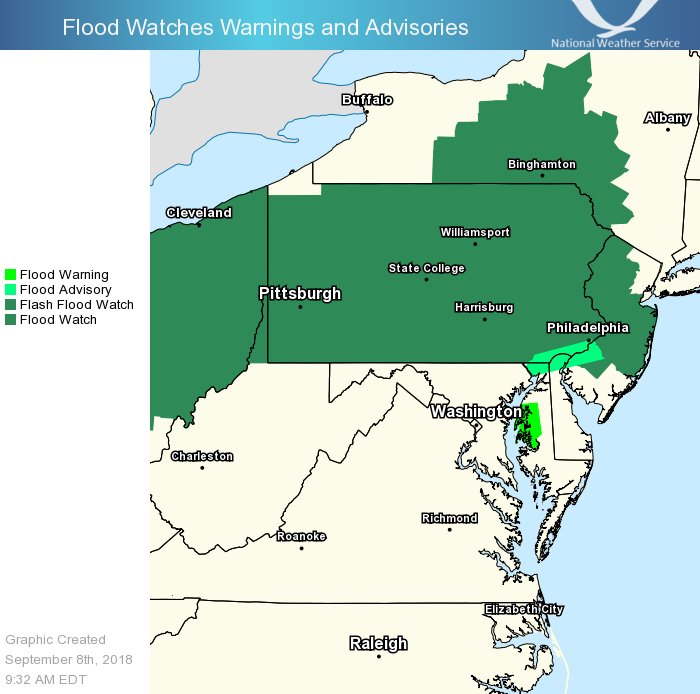
While the East Coast anxiously awaits that potential arrival of Hurricane Florence, many will need to deal with what’s left of Tropical Storm Gordon first. The tropical cyclone made landfall on the Gulf Coast earlier this week; the remnants of the system then traveled north up the Mississippi Valley. Now what’s left of its rich moisture field is moving into the Ohio Valley and the Mid Atlantic, soaking areas already soaked by a summer of heavy rainfall. Pennsylvania just wrapped up their wettest August ever on record, and unfortunately more soaking rains are headed there too.
Because of heavy rain that has fallen or is expected to fall, the National Weather Service has issued a variety of flood related advisories to alert people to the hazard.
What is the difference between a Flood Watch and a Flood Warning issued by the National Weather Service?
- Flash Flood Warning: Take Action! A Flash Flood Warning is issued when a flash flood is imminent or occurring. If you are in a flood prone area move immediately to high ground. A flash flood is a sudden violent flood that can take from minutes to hours to develop. It is even possible to experience a flash flood in areas not immediately receiving rain.
- Flood Warning: Take Action! A Flood Warning is issued when the hazardous weather event is imminent or already happening. A Flood Warning is issued when flooding is imminent or occurring.
- Flood Watch: Be Prepared:A Flood Watch is issued when conditions are favorable for a specific hazardous weather event to occur. A Flood Watch is issued when conditions are favorable for flooding. It does not mean flooding will occur, but it is possible.
- Flood Advisory: Be Aware: An Flood Advisory is issued when a specific weather event that is forecast to occur may become a nuisance. A Flood Advisory is issued when flooding is not expected to be bad enough to issue a warning. However, it may cause significant inconvenience, and if caution is not exercised, it could lead to situations that may threaten life and/or property.
The National Weather Service also cautions people: turn around, don’t drown; never drive through flood waters. Water may be deeper than it appears and can hide hazards such as sharp objects, washed out road surfaces, electrical wires, raw sewage, or even hazardous chemicals. A vehicle caught in swiftly moving water can be swept away in seconds 12 inches of water can float a car or small SUV, 18 inches of water can carry away large vehicles.